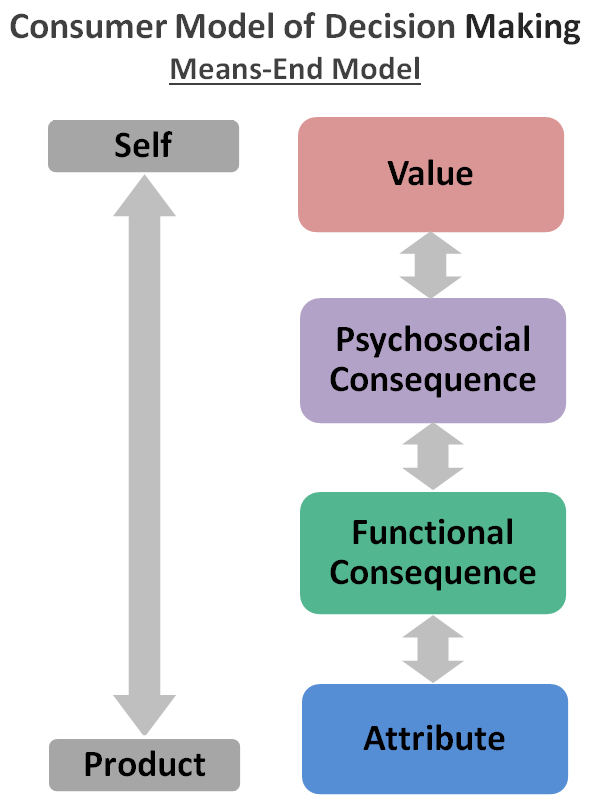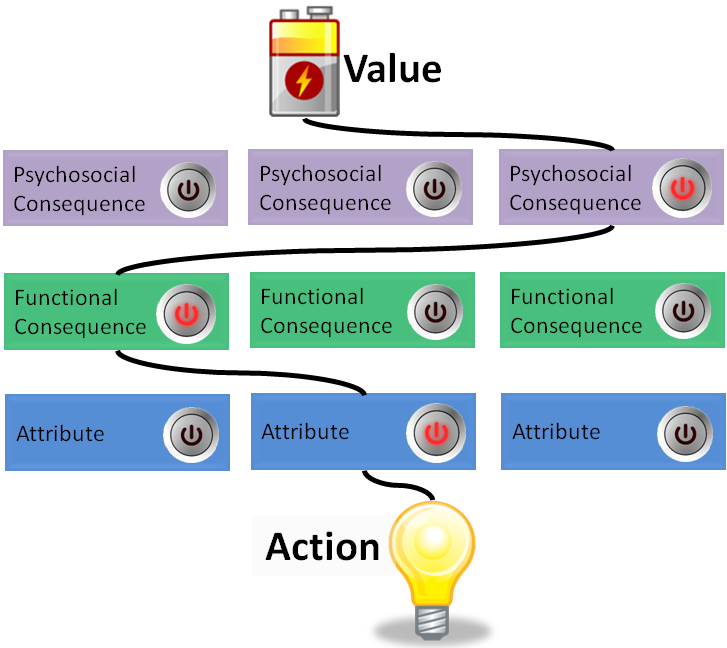Every marketer asks (rather, they should ask) the question: “How do I create truly great communications that motivate buyers to action?” The question is just as relevant to a company that buys TV spots on the Super Bowl as one that has a limited budget and relies primarily on digital channels. At the end of the day, a compelling message has to be conveyed, whether by electronic or print ads, a web site, video download or email pitch. We address the question – what makes truly successful communications – with the intent of providing a new level of insight that is based on a scientific view of buyer motivation.
To answer the question, it is necessary to build upon an established theory of consumer decision making underlying the motivation to purchase, one that has been proven to predict the motivating power of ads – the Means-End model. This theory explains consumer choice as the ability of unique product/brand attributes to satisfy consequences that range from tangible, functional outcomes to higher level emotions and values. Specifically, a consumer choice may be explained by the linkage of outcomes at four levels:
- A tangible attribute (what makes this choice preferable to others?)
- A functional outcome (or tangible benefit) that the attribute satisfies
- A deeper psycho-social consequence that the consumer experiences from the functional outcome, and
- An overriding value that dominates the decision the consumer makes.
 To illustrate, assume a consumer shopping for a new bank chooses Bank X over Bank Y. If we ask for the most important reason behind this choice, she tells us it is because Bank X has a “great mobile banking application”. If we ask for more detail, she tells us that great mobile banking provides a tangible benefit: “immediate access to information” whenever she wants from her iPhone. If we probe further, she tells us that this information makes her feel “in control of her money” (for example, she can check her balance before making a purchase with a debit card). Ultimately, our conversation with her reveals that “control” satisfies a deeper value: she feels that she is a “good steward” of her family’s finance. If this consumer is typical of many consumers in the market, Bank X has the basis of a marketing campaign rooted in its mobile banking.
To illustrate, assume a consumer shopping for a new bank chooses Bank X over Bank Y. If we ask for the most important reason behind this choice, she tells us it is because Bank X has a “great mobile banking application”. If we ask for more detail, she tells us that great mobile banking provides a tangible benefit: “immediate access to information” whenever she wants from her iPhone. If we probe further, she tells us that this information makes her feel “in control of her money” (for example, she can check her balance before making a purchase with a debit card). Ultimately, our conversation with her reveals that “control” satisfies a deeper value: she feels that she is a “good steward” of her family’s finance. If this consumer is typical of many consumers in the market, Bank X has the basis of a marketing campaign rooted in its mobile banking.
The underlying research methodology for uncovering these consumer decision paths involves a structured laddering approach reflecting the buyer decision process. MaxMessage™ typically begins with semi-structured laddering interviews that uncover potential decision paths among a small sample of potential buyers. We then deploy a proprietary quantitative survey methodology and analysis system that reveals the dominant value propositions that drive behavior. And compared to qualitative methodologies, MaxMessage™ ensures a high level of confidence due to large sample sizes that can be achieved at a reasonable cost. We are also able to assess differences in buyer motivations among target sub-groups, allowing for differentiated messaging. (The details of the approach are beyond the scope of this discussion, but you may read our whitepaper, Understanding Consumer Decision-Making with Means-End Research, if you are interested).
Using the results of MaxMessage™, effective marketing communications can be developed that harness consumer decision patterns by emphasizing the reasons to act on multiple levels and drawing strong connections between these levels. It provides consumers with understandable reasons for action and reinforces their relevance to their life goals. It is possible to diagnose an ad or communications message within the means-end framework. A marketer should learn to identify the following qualities of success:
✓ The product/brand decision is reinforced at multiple levels
✓ The message at each of the levels is clearly communicated to consumers
✓ The levels are relevant in the market, that is, they reflect actual features, benefits, emotions and values that drive decisions
✓ The ad draws strong connections between the different levels of the means-end hierarchy; it should be obvious to the audience why a unique product feature results in a valuable benefit, what emotional states derive from the benefit, and what values are implied by the choice.
It should be obvious to the audience why a unique product feature results in a valuable benefit, what emotional states derive from the benefit, and what values are implied by the choice.”
– Dr. Tom Reynolds
By articulating and connecting themes at different levels of abstraction, an ad unleashes the powerful force of the buyer’s value orientation. To use an analogy by Dr. Tom Reynolds, an expert in means-end research and brand positioning, a well-crafted ad connects a series of ideas similar to a completed electric circuit; energy flows from consumer values and emotions to the point of brand choice, compelling the consumer to act.

Summing it up, we have emphasized a few key points above. First, a communications strategy should be based on a proven science of consumer motivation, a means-end model that maps choices to intrinsic needs and values. Second, effective communications responds to this model by clearly identifying reasons for buying at multiple levels and helping the audience connect these ideas. Finally, it is possible to diagnose the effectiveness of marketing communications before it is launched. A smart approach to communications based on real science using MaxMessage™ can save millions of dollars in the end.
Written by: Gina Woodall, President
